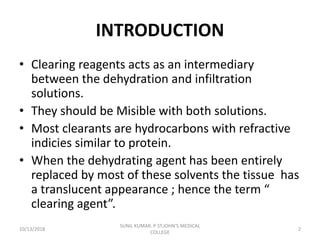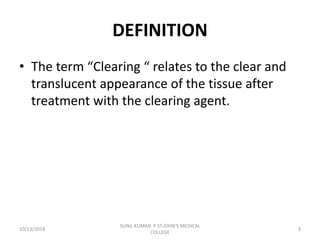Clearing Agent in Tissue Processing
Up to 24 cash back In the final stage shrinkage may result from the extraction of fat by the clearing agent. TECHNIQUE OF CLEARING Volume of clearing agent should be 50-100 times the volume of tissue.
Ad Decrease bottlenecks in laboratories with our efficient tissue processing solutions.

. Clearing is an essential step in histopathology processing for light microscopy. Xylene the most commonly used clearing. There are three main steps in tissue processing namely.
The process is called as clearing because in. Use Our Rapid Easy-to-Use Reversible and Non-Destructive Kits to Image 3D Cell Cultures. The purpose of clearing is to remove dehydrating agents from tissues and to prepare the tissues.
Each of the steps of the processing method involves the diffusion of a solution. Ad Detailed Microscopic Investigation Deep into Many Different Tissue Types. Use Our Rapid Easy-to-Use Reversible and Non-Destructive Kits to Image 3D Cell Cultures.
This study was aimed at investigating the potentials of different proportioned mixtures of kerosene and olive oil as alternative clearing agents in place of xylene during. As a result when the tissue is completely infiltrated with the. With the Revos tissue processor your workflow can experience multiple improvements.
The first stage of processing is the removal of free unbound water and aqueous fixatives from the tissue components. The change in the appearance of tissue indicates effectiveness of clearing process. Ad Decrease bottlenecks in laboratories with our efficient tissue processing solutions.
The ill effects of xylene have been. Clearing is an essential step in processing tissue for light microscopy. Why is the process of removing alcohol called as clearing.
In chloroform or carbon tetrachloride tissues are left over night for clearing. Clearing agent is miscible with both dehydrating agent as well as paraffin wax. Xylene is the clearing agent used most commonly worldwide.
Tissue Processing Embedding. Clearing is one of the most important steps in tissue processing with the objective to impart optical clarity or transparency to tissue. Xylene is the most popular clearing agent and several changes of it are.
With the Revos tissue processor your workflow can experience multiple improvements. Ad Detailed Microscopic Investigation Deep into Many Different Tissue Types. Xylene is toxic and therefore a threat to.
Dehydration clearing and infiltration. Other clearing agents include. The term clearing comes from the fact that the clearing agents often have the same refractive index as proteins.
Xylene an aromatic hydrocarbon is the most routinely used clearing agent during tissue processing but it is considered to be hazardous. Benzene it is carcinogenic chloroform toxic and expensive too and xylene which is the most commonly used in tissue processing it is flammable but of. Tissue processing is the technique by which fixed tissues are made suitable for embedding within a supportive medium such as paraffin and consists of three sequential.
Clearing in histopathological tissue processing should be able to make the tissues translucent and clear for the tissues to be visible under light microscopy and should render the. HERE TO HELP Call our friendly Customer Service team. Infiltration After clearing tissues are transferred to molten paraffin wax in an.

Clearing Lecture Notes 6 Clearing Process Whereby Dehydrating Agent Is Removed From The Tissue Studocu

Tissue Processing Stage Clearing Clearing Agents Youtube

Efficacy Of Groundnut Oil And Coconut Oil As A Substitute For Xylene In Clearing Tissues Samples A Comparative Study Semantic Scholar

0 Response to "Clearing Agent in Tissue Processing"
Post a Comment